biomimicry
Exercise
Biomimicry Mentors
 Time Estimate: 70—130 minutes
Time Estimate: 70—130 minutes
 Goal: Use inspiration from specific organisms (“mentors”) to ideate solutions to a problem.
Goal: Use inspiration from specific organisms (“mentors”) to ideate solutions to a problem.
Biomimicry can be done directly, though mentors; or indirectly, through principles. This is the direct method, finding specific organisms to be mentors and then generating ideas inspired by them. Note that there are different ways to do this. The version here is from Faludi 2013; a lengthier (eight step) method is “Biomimicry DesignLens” by Biomimicry 3.8.
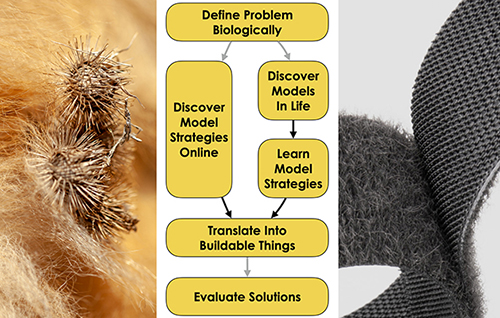
|
Velcro was inspired by burrs sticking to fur. It took ten years to go from inspiration to manufacturable product. (Images from Shutterstock and Velcro.com.) |
STEP 1: Define The Problem Biologically
 Time Estimate: 10—20 minutes
Time Estimate: 10—20 minutes
Choose a problem you’d like to solve about your product, and consider it carefully. For example, to improve a refrigerator, should your goal be to keep food cool, or to prevent food from spoiling? Once you have a clear functional definition, translate it into a biological analogy. This gives you starting places of where to look in nature: for the refrigerator redesign, how do animals stay cool in the heat of the desert? How do plants prevent decay by fungus or bacteria in jungle humidity? The problem definitions suggest different answers. Also include the use-case: dorm room or restaurant, on-grid or off-grid, rich or poor, etc.

Translating into a biological definition of the problem helps you find where to look for mentors: animals in the desert? Plants in the jungle? Others?
STEP 2: Find Mentor Organisms And Their Strategies
 Time Estimate: 30—60 minutes
Time Estimate: 30—60 minutes
This is the fun part: find biological mentors and see what strategies they use to solve your problem. There are many sources of inspiration, but the two main ones are direct observation (usually outside) and in literature (usually online).
- Outside: You can go directly observe nature, in your own backyard or in exotic locales. See if you can identify the strategies organisms use that are relevant to your problem definition. This is usually more inspiring than searching literature, but it requires an extra step (shown in the diagram at the top of the page): once you’ve found a mentor, you need to understand what strategy it’s using, and how the physics or chemistry works. This is easiest to do with an expert on the local flora and fauna, who knows these strategies and how they work.
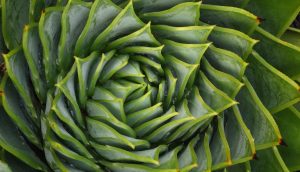
(Image from Jeremy Faludi)
- Online: AskNature.org is a searchable biomimicry database that’s easy to use. Just type in the function you’re looking for, or browse through the taxonomy of nature’s strategies. It not only shows the mentors, but explains how the strategies work. You could also search academic literature using sites like Science Direct or PubMed, if you’ve got strong science chops. You could even flip through physical books for inspiring examples; some of the best books are listed in the main biomimicry page.

(Image from AskNature.org)
Write the strategies on sticky notes so you can group them or move them around. For example, in searching for refrigerator redesign ideas, you’ll find many animals sweat to keep cool; the physical principle of how sweating works is “evaporative cooling”. Or if you search for fighting fungus (not cooling), you might find discover natural fungicides in oregano plants. Often several organisms use the same physical / chemical strategy; that’s ok, it may imply the strategy is particularly good. But make sure you have several different strategies, just to give yourself choices.
When you write down or sketch each strategy, also list the mentor organism it came from. If you want, include pictures and notes. It’s best to keep a citation or URL for each organism and strategy, in case you need more detail later.
Find as many mentors and strategies as you want, but a good number for this time limit is 5 – 15 to choose from. Find at least four strategies–two or more from AskNature, and one or more from somewhere else, just to diversify your search.
STEP 3: Translate Strategies Into Buildable Things
 Time Estimate: 20—40 minutes
Time Estimate: 20—40 minutes
For every natural strategy you listed in Step 2, list one or more ways to commercially produce it. Experts such as contract manufacturers, organic chemists, and others can help you brainstorm on manufacturability. You can also just work on your own. Line up all your sticky notes from the last step, and use a new color of sticky note to brainstorm buildable ideas for each strategy.
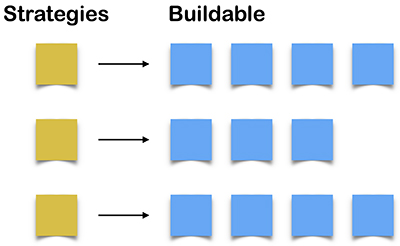
Draw or briefly describe each buildable idea on a sticky note. Each idea will have limitations, and that’s okay. For example, the refrigerator evaporative cooling strategy mentioned above can be achieved by simply using two clay pots (one porous, one impermeable) with wet sand in between. This works well in dry, breezy locations, but it doesn’t work well in very humid places with no breeze. The anti-fungal chemical from oregano is easy to apply to different fruits and vegetables, but might not work for other foods. Have many ideas, especially ones relevant to your product context.
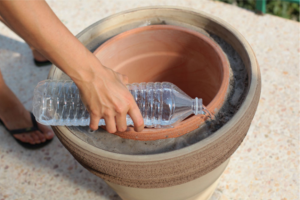
A simple pot-in-pot refrigerator (image from eudaimon-ecp.org)
This is an important step because nature’s best strategies may not be feasible for you to build with today’s technology. Biomimicry is design-by-analogy, it’s not copying nature or using natural ingredients. These translation analogies are usually the hardest part of biomimicry. Velcro took ten years to commercialize, because a new manufacturing method had to be invented. So before you choose a favorite idea, consider how to build all your ideas–it often changes which idea is your favorite.
STEP 4 (Optional): Using Principles as a Quality Control
 Time Estimate: 10 – 20 minutes
Time Estimate: 10 – 20 minutes
If you want, you can evaluate how biomimetic your new ideas “really” are, by comparing them to principles from nature, such as Biomimicry 3.8’s “Life’s Principles” shown below. (Also with explanations here). Go through your new buildable ideas one by one, and for each idea, see what principles it follows better than the original product did. This can help you choose your favorite idea(s) to move forward with.
If you notice a principle that your new ideas don’t follow well but should, you might stop and redo previous steps to find new mentors or new buildable ideas. Or you might choose to do the biomimicry principles exercise.
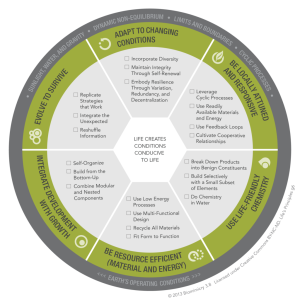
Life’s principles, from Biomimicry 3.8.
This step is optional, as most people find LCA, eco-label checklists, or other sustainability measurements to be more objective and targeted, but it’s a nice way of considering natural principles in your design process. You’ll need to do some form of narrowing down to a winning idea (or a few ideas) to move forward with.
Checklist for Self-Assessment
To score your success on this exercise, see if you…
- Formulated a clear problem statement (ideally from your Whole System Map design brief).
- Rephrased the problem biologically.
- Found 4+ strategies (2+ strategies from AskNature, 1+ strategies from elsewhere).
- Included mentor organism names (ideally also citations / URLs).
- Drew & described buildable version(s) of each strategy.
- (Optional) Evaluated winning strategies based on principles of nature.
All VentureWell Tools for Design and Sustainability content is shareable and usable by CC BY-NC-SA 4.0 license.